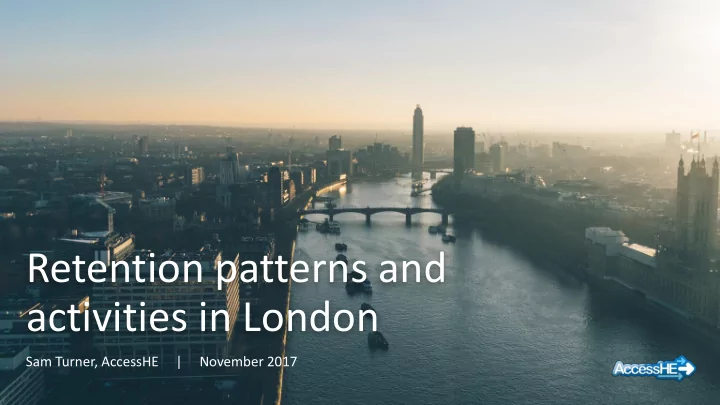

Retention patterns and activities in London Sam Turner, AccessHE | November 2017
Introduction • Growing evidence to suggest that investment (and resultant improvements) in access for disadvantaged students has failed to translate into improved outcomes. • Retention has become a critical indicator of widening participation performance. • London is seen to perform particularly poorly.
Expenditure • Institutional expenditure within student success is expected to rise to £185.1 million in 2018-19. • From 12% in 2013-14 to 23% in 2018-19. • London spend in student success is expected to rise to £35.27 million by 2021-22 – 23.8%. • Access spending still remains high. • Institutions with high drop-out rates are investing more in retention and student success.
Proportion of access agreement expenditure in student success vs institutional drop-out rate 20% 18% 16% R² = 0.6048 14% Percentage no longer in HE after one year 12% 10% 8% 6% 4% 2% 0% 0% 10% 20% 30% 40% 50% 60% 70% 80% Percentage of expenditure in student success
Exploring patterns • Ethnicity • Low Participation Neighbourhoods • Institution size and tariff band/type • State school intake • NS-SEC • NSS score
Ethnic composition of UK students vs institutional drop-out rates (London institutions) White Black Asian Other (including mixed) 20 18 16 R² = 0.6085 14 Percentage no longer in HE after one year (%) 12 R² = 0.0702 10 R² = 0.0201 8 6 R² = 0.2832 4 2 0 0% 10% 20% 30% 40% 50% 60% 70% 80% 90% 100% Percentage of ethnic composition of UK student body
Ethnic composition of UK students vs institutional drop-out rates (non-London institutions) White Black Asian Other (including Mixed) 20 18 16 14 Percentage no longer in HE after one year (%) 12 R² = 0.1096 10 8 R² = 0.0033 R² = 0.0256 R² = 0.0159 6 4 2 0 0% 10% 20% 30% 40% 50% 60% 70% 80% 90% 100% Percentage ethnic composition of UK student body
Proportion of students from Low Participation Neighbourhoods (LPNs) vs institutional drop-out rates 12% 10% Percentage from low participation neighbourhoods (POLAR3) 8% R² = 0.0622 6% 4% 2% 0% 0% 2% 4% 6% 8% 10% 12% 14% 16% 18% 20% Percentage of students no longer in HE after one year 2014-15
UCAS mean entry tariff points vs institutional drop-out rate 20 18 16 14 Percentage no longer in HE after one year (%) 12 10 8 6 R² = 0.6271 4 2 0 150 200 250 300 350 400 Mean entry tariff points
Institution tariff band and drop-out rate 14% 12% 10% London average Percentage no longer in HE after one year 8% 6% 4% 2% 0% High Creative specialist Specialist other Med Low Tariff band
Total undergraduate population vs institutional drop-out rate 20% 18% 16% 14% Percentage no longer in HE after one year 12% R² = 0.0856 10% 8% 6% 4% 2% 0% 0 2000 4000 6000 8000 10000 12000 14000 16000 18000 20000 Total undergraduate population
Total undergraduate population (by institution tariff band) vs institutional drop-out rate Low Medium High Creative specialist Specialist other 20% 18% 16% 14% Percentage no longer in HE after one year 12% 10% 8% 6% 4% 2% 0% 0 2000 4000 6000 8000 10000 12000 14000 16000 18000 20000 Total undergraduate population
Percentage of intake from state schools vs institutional drop-out rate 20% 18% 16% 14% Percentage no longer in HE after one year 12% 10% 8% R² = 0.5209 6% 4% 2% 0% 0% 10% 20% 30% 40% 50% 60% 70% 80% 90% 100% Percentage of young student intake from state schools
Percentage of intake from NS-SEC classes 4-7 vs institutional drop-out rate 20% 18% 16% R² = 0.5244 14% Percentage no longer in HE after one year 12% 10% 8% 6% 4% 2% 0% 0% 10% 20% 30% 40% 50% 60% Percentage of intake from NS-SEC classes 4-7
NSS Overall Student Satisfaction score vs institutional drop-out rate 20% 18% 16% 14% Percentage no longer in HE after one year 12% 10% 8% R² = 0.0436 6% 4% 2% 0% 70% 75% 80% 85% 90% 95% 100% NSS 2015 Overall Student Satisfaction score
Targets • Across the AccessHE membership, all but one institution have at least one retention target. • Most commonly two, but varies depending on the institution. • Often addressing total/young population and then a specific group.
AccessHE member HEI retention targets by target group Low income, 1 Disabled, 1 NS-SEC, 2 All UG, 9 BME/BAME, 2 Care leaver, 3 LPN, 4 Young, 10 Mature, 7
Themes and activities • Debate between value/effectiveness of targeted vs universal activity? • Some key themes from access agreements: • Financial support: hardship, grants and evaluation. • Peer-mentoring or peer-assisted learning and ‘buddying’ schemes: formal and informal, academic and social. • Academic skill development: ensure ‘course - readiness’ and prevent ‘falling behind’, peer learning, workshops or drop-in activity.
Themes and activities • Transition programmes for specific groups of learners: first term interventions, continuation from pre-entry schemes. • Predictive learner analytics: identification of ‘at - risk’ students, entry profile and on -course records, prediction and response. • Curriculum design and changes to assessment and feedback: inclusive teaching and learning, teaching practices, timing and processes.
Themes and activities • Personal tutoring: folding into other activities, integrating with mental health support. • Personalised approaches which recognised intersectionality: compounding effects, recognising individual students.
Summary • Expenditure – London spending on student success in line with sector average, but spending reflecting performance. • Patterns - Correlation with ethnicity, tariff/type, state school intake and NS-SEC. Weaker for LPN, NSS score and size. • Targets – Common across all institutions, but number/targeting reflecting performance. • Themes and activities – Recognition of whole-institution approach to support individual students.
Questions? Sam Turner, AccessHE sam.turner@londonhigher.ac.uk
Data sources • https://www.hesa.ac.uk/data-and-analysis/performance-indicators/non- continuation • https://www.hesa.ac.uk/data-and-analysis/publications/students-2015- 16/introduction • https://www.hesa.ac.uk/data-and-analysis/performance-indicators/widening- participation • http://www.hefce.ac.uk/lt/nss/results/2015/ • https://www.offa.org.uk/access-agreements/ (2018-19) • https://www.offa.org.uk/wp-content/uploads/2015/03/Access-agreement- 2018-19-key-facts-revised-OFFA-201708.pdf With thanks to Paresh Shah, Research Manager at London Higher for supporting with data collection and analysis.
Recommend
More recommend